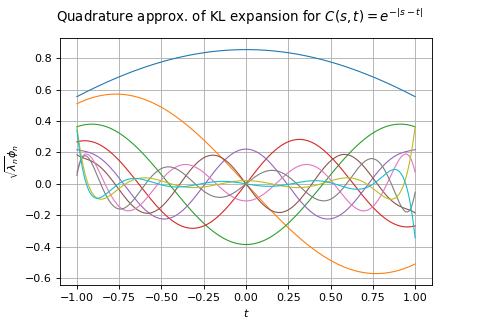KarhunenLoeveQuadratureAlgorithm¶
(Source code, png)

- class KarhunenLoeveQuadratureAlgorithm(*args)¶
Computation of Karhunen-Loeve decomposition using Quadrature approximation.
- Available constructors:
KarhunenLoeveQuadratureAlgorithm(domain, bounds, covariance, experiment, basis, basisSize, mustScale, s)
KarhunenLoeveQuadratureAlgorithm(domain, bounds, covariance, marginalDegree, s)
- Parameters:
- domain
Domain The domain on which the covariance model and the Karhunen-Loeve eigenfunctions (modes) are discretized.
- bounds
Interval Numerical bounds of the domain.
- covariance
CovarianceModel The covariance function to decompose.
- experiment
WeightedExperiment The points and weights used in the quadrature approximation.
- basissequence of
Function The basis in which the eigenfunctions are projected.
- marginalDegreeint
The maximum degree to take into account in the tensorized Legendre basis.
- mustScaleboolean
Flag to tell if the bounding box of the weighted experiment and the domain have to be maped or not.
- sfloat,
The threshold used to select the most significant eigenmodes, defined in
KarhunenLoeveAlgorithm.
- domain
Notes
The Karhunen-Loeve quadrature algorithm solves the Fredholm problem associated to the covariance function
: see
KarhunenLoeveAlgorithmto get the notations.The Karhunen-Loeve quadrature approximation consists in replacing the integral by a quadrature approximation: if
is the weighted experiment (see
WeightedExperiment) associated to the measure, then for all functions measurable wrt
, we have:
If we note
, we build a more general quadrature approximation
such that:
where only the points
are considered.
We introduce the matrices
such that
,
and
such that
.
The normalisation constraint
and the orthogonality of the
in
leads to:
(1)¶
The Galerkin approach leads to the following generalized eigenvalue problem:
(2)¶
where
and
.
The collocation approach leads to the following generalized eigenvalue problem:
(3)¶
Equations (2) and (3) are equivalent when
is invertible.
OpenTURNS solves the equation (2).
The second constructor is a short-hand to the first one, where basis is the tensorized Legendre basis (see
OrthogonalProductPolynomialFactoryandLegendreFactory), experiment is a tensorized Gauss-Legendre quadrature (seeGaussProductExperiment), basisSize is equal to marginalDegree to the power the dimension of domain and mustScale is set to True.Examples
Discretize the domain
and create a covariance model:
>>> import openturns as ot >>> bounds = ot.Interval([-1.0]*2, [1.0]*2) >>> domain = ot.MeshDomain(ot.IntervalMesher([10]*2).build(bounds)) >>> s = 0.01 >>> model = ot.AbsoluteExponential([1.0]*2)
Give the basis used to decompose the eigenfunctions:
here, the 10 first Legendre polynomials family:
>>> basis = ot.OrthogonalProductPolynomialFactory([ot.LegendreFactory()]*2) >>> functions = [basis.build(i) for i in range(10)]
Create the weighted experiment of the quadrature approximation: here, a Monte Carlo experiment from the measure orthogonal wrt the Legendre polynomials family:
>>> experiment = ot.MonteCarloExperiment(basis.getMeasure(), 1000)
Create the Karhunen-Loeve Quadrature algorithm:
>>> algorithm = ot.KarhunenLoeveQuadratureAlgorithm(domain, bounds, model, experiment, functions, True, s)
Run it!
>>> algorithm.run() >>> result = algorithm.getResult()
Methods
getBasis()Accessor to the functional basis.
Accessor to the object's name.
Accessor to the covariance model.
Accessor to the domain.
Accessor to the points and weights of the quadrature approximation.
Accessor to scale option.
getName()Accessor to the object's name.
Accessor to number of modes to compute.
Get the result structure.
Accessor to the threshold used to select the most significant eigenmodes.
hasName()Test if the object is named.
run()Computation of the eigenvalues and eigenfunctions values at the quadrature points.
setCovarianceModel(covariance)Accessor to the covariance model.
setName(name)Accessor to the object's name.
setNbModes(nbModes)Accessor to the maximum number of modes to compute.
setThreshold(threshold)Accessor to the limit ratio on eigenvalues.
- __init__(*args)¶
- getBasis()¶
Accessor to the functional basis.
- Returns:
- basis
Basis The basis in which the eigenfunctions are projected.
- basis
- getClassName()¶
Accessor to the object’s name.
- Returns:
- class_namestr
The object class name (object.__class__.__name__).
- getCovarianceModel()¶
Accessor to the covariance model.
- Returns:
- covModel
CovarianceModel The covariance model.
- covModel
- getExperiment()¶
Accessor to the points and weights of the quadrature approximation.
- Returns:
- experiment
WeightedExperiment The points and weights used in the quadrature approximation.
- experiment
- getMustScale()¶
Accessor to scale option.
- Returns:
- mustScaleboolean
Flag to tell if the bounding box of the weighted experiment and the domain have to be maped or not.
- getName()¶
Accessor to the object’s name.
- Returns:
- namestr
The name of the object.
- getNbModes()¶
Accessor to number of modes to compute.
- Returns:
- nint
The maximum number of modes to compute. The actual number of modes also depends on the threshold criterion.
- getResult()¶
Get the result structure.
- Returns:
- resKL
KarhunenLoeveResult The structure containing all the results of the Fredholm problem.
- resKL
Notes
The structure contains all the results of the Fredholm problem.
- getThreshold()¶
Accessor to the threshold used to select the most significant eigenmodes.
- Returns:
- sfloat, positive
The threshold
.
Notes
OpenTURNS truncates the sequence
at the index
defined in (3).
- hasName()¶
Test if the object is named.
- Returns:
- hasNamebool
True if the name is not empty.
- run()¶
Computation of the eigenvalues and eigenfunctions values at the quadrature points.
Notes
Runs the algorithm and creates the result structure
KarhunenLoeveResult.
- setCovarianceModel(covariance)¶
Accessor to the covariance model.
- Parameters:
- covModel
CovarianceModel The covariance model.
- covModel
- setName(name)¶
Accessor to the object’s name.
- Parameters:
- namestr
The name of the object.
- setNbModes(nbModes)¶
Accessor to the maximum number of modes to compute.
- Parameters:
- nint
The maximum number of modes to compute. The actual number of modes also depends on the threshold criterion.
 OpenTURNS
OpenTURNS